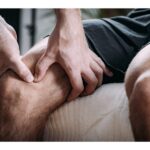If you have ever suffered a muscle strain or pulled a muscle, you probably know how painful it can be. That’s why it’s important to learn as much as you can about this common injury.
Unless you’re experiencing severe symptoms, you can usually treat a muscle strain yourself with at-home treatments like rest, ice and over-the-counter pain medication. Your healthcare provider may also recommend rehabilitative exercises to help your injured muscle recover.
What is a Muscle Sprain and How Does it Happen?
A muscle strain is a type of injury in which muscle fibers tear. They happen most often near the point where a muscle joins its tough, fibrous connective tissue, called the tendon.
In most cases, a muscle strain can be treated at home. Rest, ice, compression and elevation (RICE) helps with the healing process.
Muscle strains are categorized as mild, moderate and severe. Mild strains affect only 5% of a muscle’s fibers, causing pain and swelling that typically goes away in a day or two.
Grade II strains involve about half of a muscle’s fibers, cause significant pain and swelling and decrease strength. Grade III strains result in complete rupture of a muscle, sometimes causing a “pop” sensation as the muscle tears into two separate pieces or shears away from its tendon.
Common Causes of Muscle Sprains
Getting enough rest, icing and over-the-counter medicine can help relieve pain and swelling. You may need to see a doctor if the injury doesn’t improve, or if it gets worse.
Muscle strains can happen to anyone. But risk factors such as poor body mechanics, repetitive injury, and cold weather increase your chances of a muscle strain.
Mild strains typically heal on their own within a few weeks. More severe strains require medical treatment and can take months to fully recover.
Signs & Symptoms of a Muscle Sprain
A muscle strain is a tear or a stretch of the fibers in your muscles. Its a common injury but it can be painful.
Your doctor will diagnose a muscle strain with a physical exam and some tests. These tests can help them see if your muscle is torn and if it’s caused other injuries, such as ligaments or tendons.
You should rest the injured muscle until you’re feeling better. This can take 10 days to 3 weeks for a mild strain and up to 6 months for a severe strain.
Your doctor may prescribe ibuprofen to reduce pain and swelling. But avoid NSAIDs because they can cause stomach bleeding and kidney problems in some people.
Diagnosis & Treatment of a Muscle Sprain
A doctor diagnoses a muscle strain by looking at the injury asking questions about how it happened and asking about your symptoms. The doctor may order imaging studies such as X-rays.
Expert diagnosis and treatment in la clinica muscle sprains. Skilled team provides personalized care, including rest, ice, compression, elevation (RICE) and may recommend physical therapy or pain medication as needed.
A muscle strain usually heals on its own but some people experience long-term symptoms such as weakness in the injured muscle. This type of strain is called chronic muscle strain and often develops over time especially in people who participate in contact sports such as football or hockey.
How long it takes for a muscle strain to heal depends on the severity and location of the injury. Most Grade I strains can heal within a few weeks.
Preventing Future Muscle Sprains
If you have ever strained a muscle you know the pain and hassle that come with recovering from an injury. Fortunately, there are ways to prevent future strains.
The first step is addressing the cause of your initial injury. This may mean changing your workout routine or avoiding activities that place too much stress on your body.
Another way to prevent future strains is to do physical therapy to strengthen the muscles that are most susceptible to injury. Lastly, make sure you are hydrating well and eat a healthy diet to keep your body nourished. With these tips you can rest easy knowing that your body is in good hands! After all, no one wants to deal with a muscle strain again. It’s worth the effort to take care of your body!
